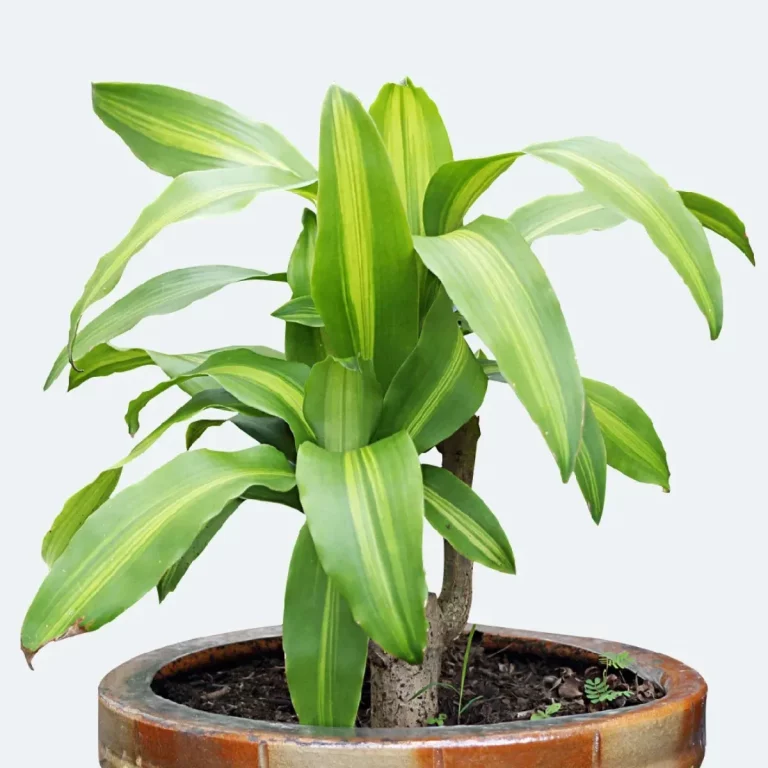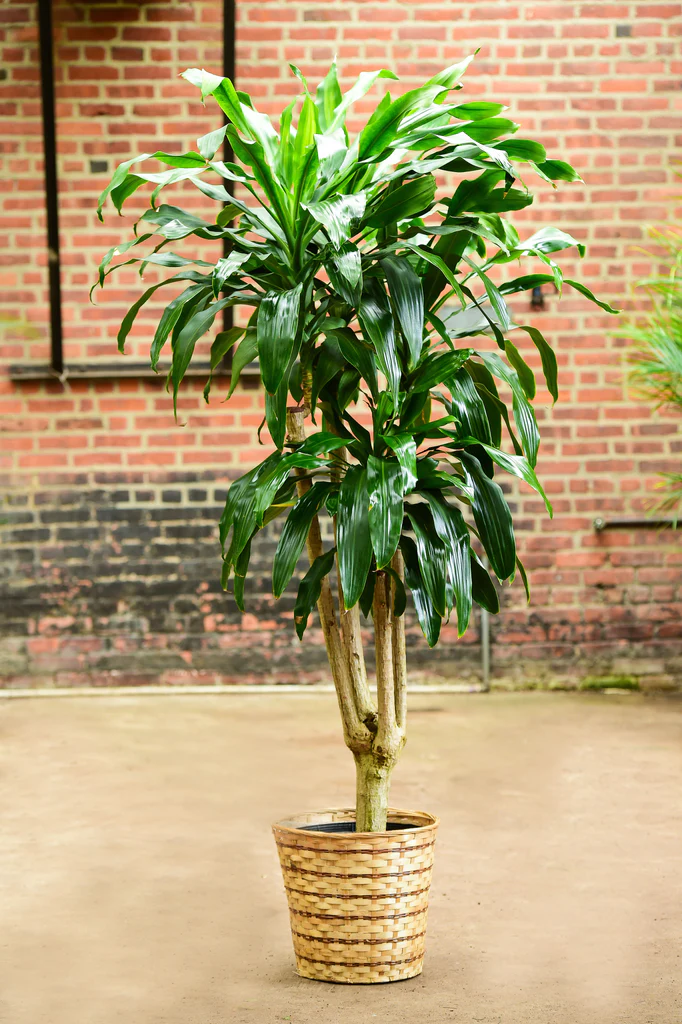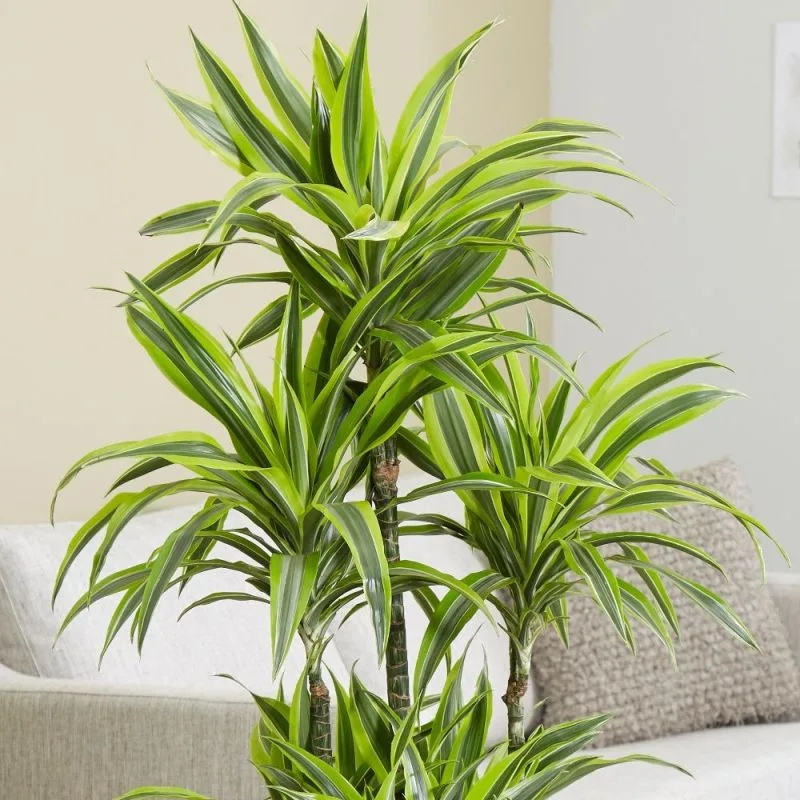Index
Introduction
Mass Cane Plant (Dracaena fragrans), also known as “Dracena”, is a popular ornamental plant appreciated for its elegance and easy care. Originally from tropical Africa, this indoor plant captivates plant lovers with its long arching leaves and unique growth patterns.
With its lanceolate leaves and slightly wavy edges, Mass Cane Plant adds a tropical touch to any environment. Its resilience makes it an ideal choice for those looking for an easy-care plant, adapting well to medium light conditions and moderate watering.
Meaning of Mass Cane Plant
In addition to its aesthetic beauty, Mass Cane Plant is often associated with symbolic meanings, representing good luck and prosperity in some cultures. Its presence indoors not only adds a touch of nature, but also carries with it an aura of positivity and harmony.
| Common Name | Mass Cane Plant |
|---|---|
| Botanical Name | Dracaena fragrans |
| Family | Asparagaceae |
| Plant Type | Evergreen shrub |
| Adult Size | Up to 3 meters high |
| Sun exposure | Indirect light to shade |
| Soil type | Well-drained and rich in organic matter |
| soil pH | Slightly acidic to neutral |
| Flowering time | Rarely blooms indoors |
| Flower color | White or cream |
| Native Area | Tropical Africa |
| Toxicity | Slightly toxic to pets |

How to Care for the Mass Cane Plant
Discover the secrets to keeping your Mass Cane Plant healthy and lush with essential care tips:
Light
Keep the plant in places with indirect light and shade, avoiding direct exposure to the sun which can cause burns to the sensitive leaves.
Soil
Use well-drained soil rich in organic matter, ensuring good aeration and retention of essential nutrients.
Water
Water moderately, allowing the soil to dry out between waterings. Avoid excessive water accumulation, which can lead to root rot.
Temperature and humidity
Keep the plant in a room with a temperature between 18°C and 24°C and provide moderate humidity around it.
Fertilizing
Fertilize during the growing season with a balanced fertilizer, following the product instructions. Avoid over-fertilization to prevent the accumulation of salts in the soil.
By following these specific guidelines, you will ensure an environment conducive to the healthy development of the Mass Cane Plant.
How to make Mass Cane Plant seedlings
If you want to multiply the charm of your Mass Cane, the process of making cuttings is a rewarding option. Follow these simple steps:
Choosing the material
- Select a healthy, mature plant to take cuttings from.
Preparing the seedling
- Cutting: Use sharp scissors to make cuts at the base of a healthy leaf, removing about 10 to 15 centimeters.
- Leaf removal: Remove the leaves from the bottom, leaving only a few on the top.
Rooting
- Containers: Plant the cuttings in containers with light, well-drained soil.
- Humidity: Keep the soil moist by covering the cuttings with transparent plastic to create a humid environment.
- Developed roots: Once the roots have developed, the seedlings are ready to be transferred to larger pots or directly into the ground.

How to plant Mass Cane Plant
When planting Mass Cane, follow these instructions to ensure a healthy establishment:
Site selection
- Choose locations with indirect light to shade, protected from strong winds.
Preparing the soil
- Make sure the soil is well-drained and enriched with organic matter.
Planting
- Digging: Dig a hole slightly larger than the plant’s root ball.
- Positioning: Place the plant in the hole, leveling it with the surrounding soil.
- Backfill: Fill with soil, pressing gently around the base.
- Watering: Water abundantly and keep the soil moist for the first few months.
By following these guidelines, you will provide the ideal conditions for your Mass Cane to flower and develop vigorously.
Mass Cane Plant pests and diseases
Keep an eye out for the main pests and diseases that can affect your Mass Cane and learn how to combat them effectively:
Common Pests:
- Mites: Small arachnids that cause yellowing and spots on the leaves.
- Mealybugs: Insects that feed on the sap, leaving a sticky substance on the leaves.
- Aphids: Small sucking insects that can cause deformities in the leaves.
Frequent diseases:
- Root rot: Caused by excess water, resulting in root decay.
- Leaf spots: Dark marks on the leaves due to fungi or bacteria.

Common Problems and Their Solutions
Yellowing leaves:
- Cause: Overwatering or lack of nutrients.
- Solution: Adjust the frequency of watering and provide a balanced fertilizer.
Dry tips:
- Cause: Low humidity or exposure to direct sunlight.
- Solution: Increase humidity around the plant and move to locations with indirect light.
Falling leaves:
- Cause: Sudden changes in temperature or excess water.
- Solution: Maintain consistent conditions and water moderately.
By identifying these problems promptly and applying the appropriate solutions, you will ensure a healthy environment for your water lily to thrive in.
Curiosities and myths
Explore the fascinating universe of Mass Cane Plant through intriguing facts and unravel myths surrounding this charming plant:
Surprising Curiosities:
- Tropical Origin: Native to tropical Africa, Mass Cane brings with it the exuberance and vitality of tropical regions.
- Remarkable Adaptation: Its adaptability makes it ideal for indoor environments, providing elegance in a variety of locations.
- Cultural Significance: In some cultures, theMass Cane is associated with good luck and prosperity, symbolizing positive energies.
Myths dispelled:
- Exaggerated Toxicity: Although it has a mild level of toxicity for pets, Mass Cane is not as harmful as some myths suggest.
- Indoor Flowering: Contrary to common myth, Mass Cane rarely blooms indoors, being appreciated mainly for its foliage.
By exploring these curiosities and dispelling myths, you’ll broaden your understanding of Mass Cane, turning the experience of caring for this plant into an even more enriching journey.
Conclusion
Throughout this guide, we’ve delved into the fascinating world of Mass Cane (Dracaena fragrans), uncovering its secrets, debunking myths and exploring the nuances that make this plant so special. Originally from vibrant tropical Africa, Dracaena fragrans captivates not only with its beauty, but also with its remarkable adaptability, transforming indoor environments with its elegant presence.
From its surprising curiosities, such as its association with positive cultural meanings, to the essential care required for healthy cultivation, every aspect of Mass Cane reveals its uniqueness. By understanding the importance of light, suitable soil, moderate watering and dealing effectively with pests and diseases, you create the ideal conditions for this plant to thrive in all its splendor. Cultivating Mass Cane goes beyond caring for a plant; it’s immersing yourself in an experience that combines nature, culture and a touch of botanical magic, transforming your space into a veritable green oasis. Let yourself be enchanted by this journey and discover how Mass Cane can enrich your life and your environment.
Frequently Asked Questions
What is the energy of the dracena plant?
Dracena fragrans, popularly known as Mass Cane, is associated with positive and purifying energy. Its presence is believed to bring vitality, prosperity and balance to the environment, according to some belief practices.
How to care for the Dracena fragrans plant?
To keep Dracena fragrans healthy, it is essential to provide indirect light to shade, well-drained soil and moderate watering. Avoid excessive water accumulation and provide an environment with consistent temperature and humidity.
Is it good to have dracena at home?
Having Dracena fragrans at home offers many benefits. In addition to its ornamental beauty, the plant helps to improve air quality by removing pollutants. Its presence is also associated with a more relaxing and positive atmosphere, making it an excellent choice for indoor environments.







